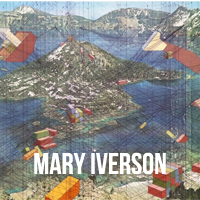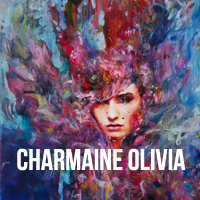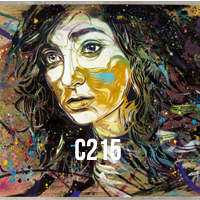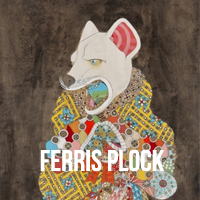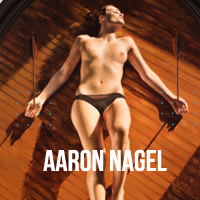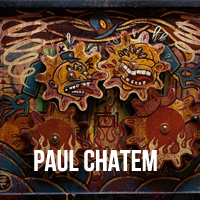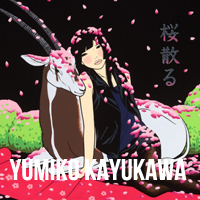Shooting Gallery Exclusive: Interview with Zaya

Yesterday morning I sat down with Zaya, whose show Steppe Warriors will be opening this Saturday, December 15th, at Shooting Gallery. Born and raised in a small town in Southern Mongolia, Zaya now lives with his wife and children in Japan. Frequent travels around the world (Hong Kong and Singapore are next on his travel wishlist) allow the artist to fulfill a wanderlust that has been with him since he was a child, growing up in an isolated town where the only way for a kid to sneak off to bigger cities was to hop on a passing truck and hold on for four hours. Perhaps all the roaming is a remnant of the nomadic lifestyle Zaya’s ancestors thrived on. The artist certainly looks to these herdsmen to inspire the ink and watercolor beauties of Steppe Warriors. Read below for a deeper look at Zaya’s influences, heritage, and how the fall of communism in Mongolia has diffused into his work.
Steppe Warriors, New Works by Zaya
Opening Reception – Saturday, December 15th, 7-11pm
On View Through January 5th, 2025
@Shooting Gallery, 839 Larkin St.
San Francisco, CA 94109
More After the Jump
Many of these paintings have a religious feel, like Tibetan thangkas. In the early 20th century, Mongolians borrowed from this tradition to create more secular pieces known as zurag. Do you consider yourself to be part of this lineage? Are your pieces then completely secular, or do they embody some religiosity?
My paintings are fundamentally related to religious art, fundamentally Buddhist art. Tibetan and Mongolian Buddhist art are similar, and studying them helped me to develop my styles and techniques. My first paintings were thangkas and it’s how I developed my beginning skills as an artist.
Having spent two years of your adolescence in a monastery, how were you able to find your creative voice in this environment?
My artistic soul originally came from my family I believe. My father was an art teacher, so I had that in me. Monasteries were full of beautiful art, and being able to go into one was a symbol of freedom. 750 monasteries were destroyed during Mongolia’s years under communism. None survived in my town, so I went into one that was rebuilt. It was a place of inspiration.

Do you feel like the young generation in Mongolia is seeking to rediscover its traditional artistic roots after years of soviet oppression, or are they instead attempting to fully modernize?
When I was growing up I got to see the collapse of communism in the nation. For 70 years people didn’t have the freedom to look back at their own history, so with the huge cultural shift to democracy people began to rediscover old traditions, to really look at who they are and where they come from. Things are still changing so fast in Mongolia after 20 years of democracy. It’s the fastest growing nation economically, and the young generation is different than my own. Young people are going more and more contemporary, looking to a new school.

Animals play a large part in traditional Mongolian life, with nomadic tribes relying on horses for travel and livestock for food and clothing. While you represent these traditionally important animals in your paintings, you also include more exotic forms of wolves and leopards. What significance do these wild animals have to you and the scenes they inhabit?
Mongolian people live closely with nature, we have a nomadic and herdsmen background. Livestock can be moved from place to place while avoiding the harsh climate, but wild animals like the wolf cannot. Wolves have never been dominated by a human being, and there is a respect in that. A symbol of nature being beyond us. Even Ghengis khan believed the blue sky is like God, and that we shouldn’t destroy it. Mongolian military training would often be through hunting parties, but there were rules to the hunt to protect nature, it would never be in the spring when mothers would be with their new borns, never in the summer when the animals are weak and skinny. Only in the autumn. That’s what’s taking place in my scene with the boar. Many of the successes of the Mongolian warriors are due to techniques for winning battle discovered through hunting.
You have a great versatility in your portrayal of figures, with features ranging from being highly stylized to more illustrative. Do you aim to reference a variety of styles in your overall body of work?
There are a lot of stories so I match the style to the story. For many paintings I do a lot of research because they’re telling tales of the past. I research clothing and culture from different centuries. I use many different references through studying central Asian ancient art, especially ancient Persian and Chinese art, Japanese, Mongolian and Tibetan. Ghengis khan’s empire had conquered for almost 300 years, so elements of Mongolian culture are seen in all these different places. By studying these arts I’m learning more about Ghengis khan’s influence.

Your artwork seems to draw mainly from two themes: hunters and warriors, and portraits of aristocratic women. Are there specific qualities you consciously try to imbue each gender with?
In Mongolia, women and men were considered equals or often women were considered higher than men. Men were raised to be warriors and women were in charge of everything else, they held all the responsibility and were highly respected. In my portraits I want to show the women’s heavenly character, not just their beauty.

The headdresses of the women in this current body of work are extremely striking. Some are shaped like vertical pillars while others appear to resemble goat horns. Are these different types used to signify various tribes or social classes?
There are many different tribes and each have different dress associated with them. I’m drawn to all the traditional hairdress and costumes. They’re so ornamental and heavenly. Even the Star Wars movies wanted to use traditional Mongolian influence, that’s where Princess Leia’s hairstyle comes from.
You’ve included some calligraphy in your new work. Is this written in Mongolian? What does it say?
It is written in Mongolian. During the era of communism they stopped teaching it, instead they taught Russian letters, so these days it’s rarely used, and not everyone can read it but my father taught me to write it when I was a child. In “Delight” there is a poem on a woman’s beauty by the poet Choinam. In “The Battle,” the calligraphy is a Genghis khan statement, it translates roughly to “Between the sun rising to the sun’s end- all that space belongs to the empire.”


